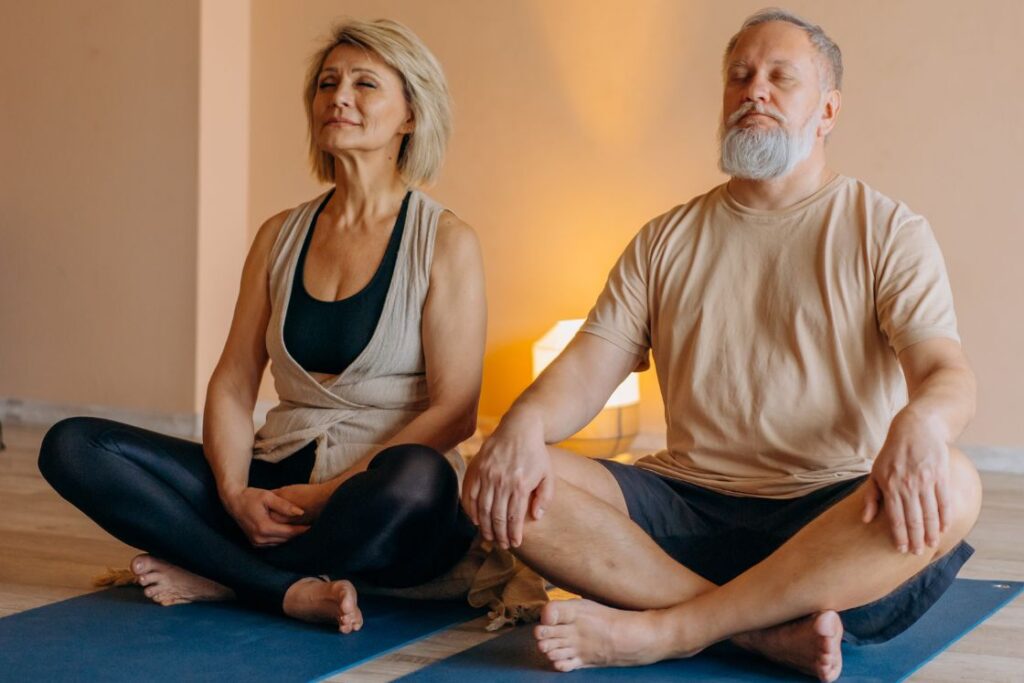
Making time to sit down and connect with your loved ones in today’s highly competitive world can be difficult, mainly as you go through the motions of your daily tasks.
With the advancement of technology, we have been limited to our screens. Our degree of ease in this space has caused a sharp reduction in the necessity to put an effort into face-to-face interactions.
It’s important to recognize the true fulfilment that stems from sharing our feelings and thoughts, which in turn helps us to relax. There are many methods for us to unwind and reconnect with both ourselves and others. One method to calm the body and mind is through meditation.
Engaging a community of like-minded individuals in meditation, even just once a week, offers many advantages for the mind, body, and spirit. People can relax and keep their minds open when they meditate in a group because it feels like everyone is on the same page.
In today’s article, we are going to delve into the benefits of meditating together, whether can be as couples, in a group, or as a community.
The Science of Meditating Together
While the benefits of meditation, in general, are well known, science is also trying to assess if there is credibility in meditating in large numbers.
In one such study about dyadic meditation (meditation done by two people together), conducted in 2017, the voluntary participants underwent a 9-month meditation training. They were engaged in meditation techniques such as “body scan” and “loving-kindness meditation”. The participants were also randomly paired with a new partner every week.
These couples shared their feelings, sensations experienced during meditation, or any recent experiences.
At the end of 9 months, The results demonstrated that even though the partners changed each week, partner exercises boosted participants’ sense of intimacy and elevated their desire to open up to partners over time. This shows that dyadic meditation benefits social connections generally, rather than just to a particular partner, rather than just to them.
Study – Effects of Group Practice of the Transcendental Meditation
Another study, which was conducted over a period of 17 years, bought forth its conclusions on the positive effects of group transcendental meditation on stress-related mishappenings in the united states. Moreover, when the size of the group was reduced, there was a rise in stress levels again.
Such was the impact of this study, that it was suggested that larger meditation groups should be organized on a global level.
Based on the above research findings, it is safe to say that group meditation does have its own set of advantages. It has shown that meditating together can alter the mind of all participants as a whole in addition to lowering heart rate, stress, and depression on an individual level.
Benefits of Meditating Together

In India, since the beginning of time, people who were sincere in their desire to experience divinity, peace, and mental clarity have pursued the fellowship of saints or meditated in groups of like-minded spiritual aspirants on their images.
The spiritual vibrations of those around you have the capacity to raise your own. On your ascent up the Self-realization ladder, they serve as your inspiration. You can accelerate your progress by practising meditation alongside other devotees. You may also aid them by setting an example for them.
Meditating together can offer many benefits for you and your partner. From deepening your connection to improving communication, these benefits can help strengthen your relationship and cultivate a greater sense of well-being.
- Enhances relationships: Meditating together can improve communication, increase trust, and deepen emotional connections between individuals.
- Increases sense of community: Group meditation creates a shared sense of purpose and belonging, promoting a sense of community and shared experience.
- Creates a sense of accountability: Meditating with others can increase motivation and discipline, making it more likely for individuals to stick to their meditation practice.
- Improves focus and concentration: Practicing meditation in a group setting can enhance focus and concentration by reducing distractions and providing a supportive environment.
- Reduces stress and anxiety: Meditating together can help reduce stress and anxiety by promoting relaxation and creating a calming environment.
- Deepens meditation practice: Meditating with others can deepen one’s own meditation practice by exposing individuals to new techniques and perspectives.
- Enhances feelings of empathy and compassion: Group meditation can enhance feelings of empathy and compassion, promoting a sense of connectedness and shared humanity.
- Boosts overall well-being and mental health: Regular group meditation can improve overall well-being and mental health by reducing stress, increasing self-awareness, and promoting a positive outlook on life.
- Promotes better sleep: Meditating together can improve sleep quality by reducing stress and promoting relaxation.
- Can increase happiness and positivity: Meditating with others can increase feelings of happiness and positivity by promoting a sense of gratitude and contentment.
What do You need to consider When Meditating with others?
The opportunity to share and advance your meditation practice with others is provided by joining meditation groups. These groups offer a sense of belonging, motivation, and a safe haven to interact with others while enhancing and stabilizing your practice.
Try attending an open session at a nearby yoga and meditation facility if you don’t have any companions to meditate with in order to reap the rewards of meditation in a group setting. It’s common for them to have sizable meditation practice areas and accessible times.
There are some considerations that you should keep in mind when meditating with others. Below we have discussed them one by one.
Size of the group
The first thing you want to decide is the size of the group. Do you want to practice with a big group of 10 people or you are happy with a handful of friends?
There is no required minimum of participants. While some people like the intimacy of small groups, others find that the greater energy of bigger numbers gives them more support.
You can also opt for online meditation groups if you are unable to find any studio or meditation groups nearby.
Larger groups offer possibilities to network and meet new people based on the changing numbers. Whereas smaller closed groups make way for gradual bonding. Your group will stand out depending on whatever option you select.
Meditation Schedule and Format
The activities scheduled for the group meditation will have a big impact on how frequently and how long each meeting occurs. Depending on the participants’ preferences, you might meet every week, every two weeks, or even once a month.
Moreover, you might want to look into the after-session programs that the groups might have planned. If your group plans to conduct mindful discussions, perform chanting, or hear a speaker followed by thoughtful debate, your session may last an hour or last the entire evening.
Sometimes, groups like to take a walk, share their emotions after a meditation session, even perform a reading of a book or even share a meal in a peaceful environment. These things might take additional time so you might have to plan your day accordingly.
Place of Meditation Session
When you move in groups, searching for and selecting a space is one of the biggest challenges. While your backyard or living room space may be sufficient for 2-3 people, anything more than those numbers requires a large space.
You also have to factor in the surrounding environment. Since this is a meditation group, you require as much peace and calmness as possible to make your session successful.
Many community centres have big halls or rooms that can be utilized for larger groups. Some parks have a gazebo or a secluded space where a handful of people can sit and meditate.
Whatever place you chose, make sure that it is airy with enough light and the surroundings are not too noisy.
How to meditate together?

Meditating together can be a powerful way to deepen your practice and cultivate a sense of connection with you and your partner. To get started, find a group or partner who shares your interest in meditation. You can attend a meditation class or workshop, join a meditation group or community, or simply invite a friend to meditate with you.
When it comes to the type of meditation to practice, there are many options available. One simple technique that can be done in a group setting is mantra meditation, where you repeat a Mantra (word or phrase) to focus your mind and quiet your thoughts. As meditation teacher Sally Kempton notes, “Mantra meditation is an excellent practice for group settings because it’s easy to do and can help synchronize the group’s energy.”
As you begin your meditation practice together, it’s important to set an intention and establish a sense of focus and presence. You might start with a few minutes of deep breathing or a guided meditation to help quiet your mind and settle into your body. Meditation teacher Tara Brach advises, “Take a few moments to pause, check in with yourself, and set an intention for your practice together.”
Step-by-step guide
Meditating with a partner can be a beautiful way to cultivate a deeper sense of connection and peace in your relationship. You can get started on your journey together towards greater mindfulness and well-being.
Here are some tips to begin meditating together:
- Choose a comfortable and quiet space: Find a place where you and your partner feel comfortable and can sit or lie down without being disturbed. It can be helpful to light some candles or incense to create a peaceful atmosphere.
- Decide on a meditation technique: There are many different types of meditation for group sittings, so it’s important to choose one that resonates with both of you. Some options include breath awareness, loving-kindness meditation, or guided visualization. You can also experiment with different techniques and see what works best for you.
- Set an intention: Before you begin, take a moment to set an intention for your meditation. This can be something like “to cultivate compassion” or “to release stress and tension.” It can be helpful to share your intention with your partner so you can support each other in your practice.
- Sync your breathing: Breathing together can help create a sense of unity and connection. Start by taking a few deep breaths together, and then settle into a comfortable rhythm. You can also try counting your breaths together to help focus your mind.
- Embrace silence: Although it can be tempting to chat or giggle, try to embrace the silence and stillness of your meditation practice. This can help deepen your connection and create a sense of peace and calm.
Types of meditation to practice together

For beginners, it is always beneficial to start with a guided meditation technique. With guided meditations, a narrator usually guides you and gives instructions as you go along. This is useful if you’re a beginner to meditation or are looking to concentrate on a certain thing, like relaxation or stress release.
Loving-kindness meditation is another favourite among group meditation practitioners. This involves sending out feelings of love, kindness, and forgiveness to not only yourself but to the world at large. You are opening your heart to giving and receiving love. It helps us see and accept ourselves and others by opening up our hearts and minds.
Another easy and simple meditation technique is Walking Meditation. There are many people who enjoy a walk with their friends, family, spouse, or children as a form of relaxation and unwinding in the evening. You simply have to concentrate on your breathing and the motion of your body as you walk.
Walking meditation is considerably easy to practice with a group as you do not need any specific place or a large area. You can take a walk in a park or even in your locality.
There are many groups that often consider practising Silent Meditation frequently. As the name suggests, silent meditation involves sitting in a quiet place in silence for an extended time. When you practice silent meditation in a group, you often feel a deep energy resonating within you. The power of silence is strong and palpable which makes you realize your true worth in this world.
Conclusion
Being able to exchange experiences with other participants in meditation groups is often regarded as a rich aspect of the gathering. We develop tolerance, respect, and love in phases because they amplify the effort we put forward, producing outcomes far exceeding individual efforts.
In addition to holding us accountable, a support system provides us with support when we are in need of reassurance of the benefits of meditation. In a meditation group, they have our backs, but we are also available to the group.




